A Historic Landmark Sidi Saiyyed Mosque To Visit And Spiritual Tranquillity In 2025
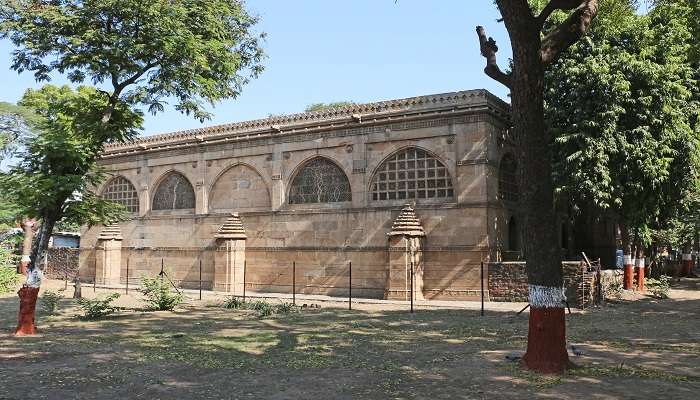
Situated in the heart of a 600-year-old walled city of Ahmedabad, Gujarat, the Sidi Saiyyed Mosque is a tribute to the grand engineering of a stone in place by the African diaspora in India. The Sidi Saiyyed Mosque is one of Ahmedabad’s most famous monuments for its exquisite latticed windows or jalis that depict the intricate intertwining branches of the ‘tree of life’. Built in 1573 AD, this monument was the last great building in Gujarati style before the Mughal conquest and was built by Sidi Saiyyed. This prestigious mosque is also considered a unique piece of Indo-Islamic architecture, and although it does not have a dome, it still functions as a place of worship.
Sidi Saiyyed Mosque History
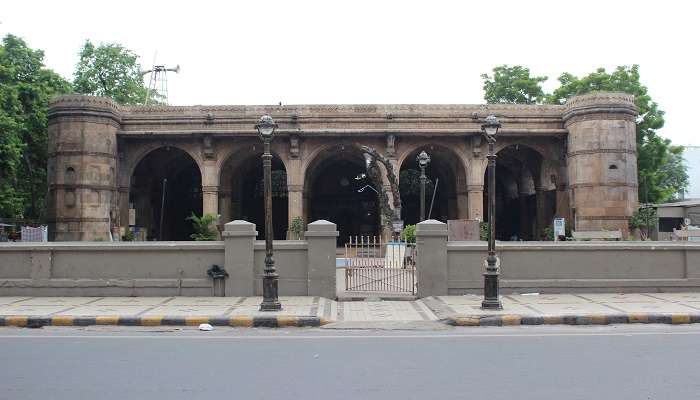
During the 16th century, several Sidis (people of African descent) who had come to Gujarat as slaves or maritime labourers rose to prominent positions of power as military commanders of the Sultans. These Africans were referred to as Sidis or Habshis from the Arabic-Persian word for “people from Abyssinia or Ethiopia”. One such Sidi was Shaykh Saiyyed Al-Habshi Sultani, simply known as Sidi Saiyyed, who constructed this eponymous mosque. He commissioned the building of this mosque along the walls of the city.
During the British colonial period, this monument served as an office for the Mamlatdar of Daskroi Taluka, where doors were installed, the mihrabs were converted into presses, and the interior was whitewashed. Only on his official visit to Ahmedabad did Lord Curzon, Viceroy of India, instruct the Mamlatdar office to be vacated to preserve the historic monument. Popularly known as Sidi Sayed ni Jali, this mosque was built in the same year the Mughals conquered Gujarat, making it an example of the final evolution of the architectural style that developed during the reign of the Gujarat Sultanate.
Must Read: Things To Do In Ahmedabad
Sidi Saiyyed Mosque Architecture
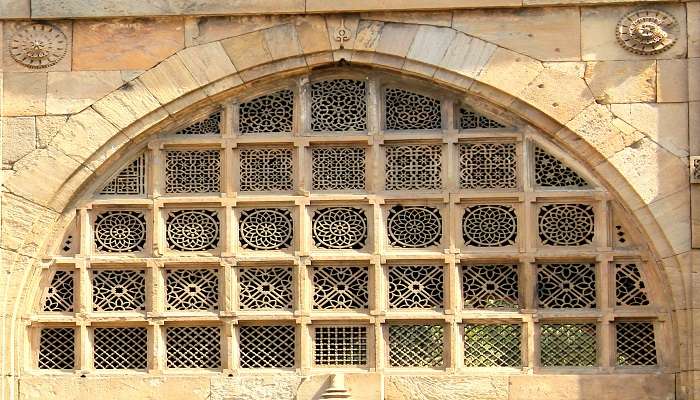
Known for its ten intricately carved stone latticework windows (jalis) on the side and rear arches, the Sidi Saiyyed Mosque Ahmedabad is entirely arcuated. Some of this latticework displays complex geometrical designs, while the two bays flanking the central aisle are carved in a manner of intertwined trees and foliage. This intricately carved lattice stone window is the Sidi Saiyyed Jali, which later became the unofficial symbol for the city of Ahmedabad. The jail also serves as an inspiration for the design of the logo of the Indian Institute of Management Ahmedabad.
The sixteen-foot-tall carvings on the jalis represent the Tree of Life motif, an artistic representation of a tree believed to grow in paradise according to Islamic mythology. The central arch of the mosque lacks intricate latticework, grabbing attention away from the stunning work at the back of the wall.
Sidi Saiyyed Mosque Timings And Ticket Price
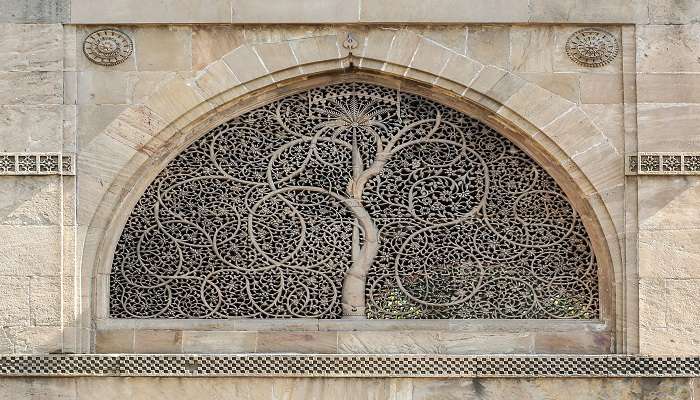
You can visit the mosque at 7:00 am when it first opens and 6:00 pm when it shuts, and there is no entry fee for visiting the religious sanctum. Since the mosque is busiest on Friday, it is advisable not to take a particular route during the prayer masses. On Sundays, you will find children conversing with seniors to get clarification about their holy book and some additional doubts.
Suggested Read: Best Resorts Near Ahmedabad
Sidi Saiyyed Mosque: Nearby Attractions
Explore the multiple attractions near the Mosque and collect the stunning memories to embark on your trip.
Kankaria Lake
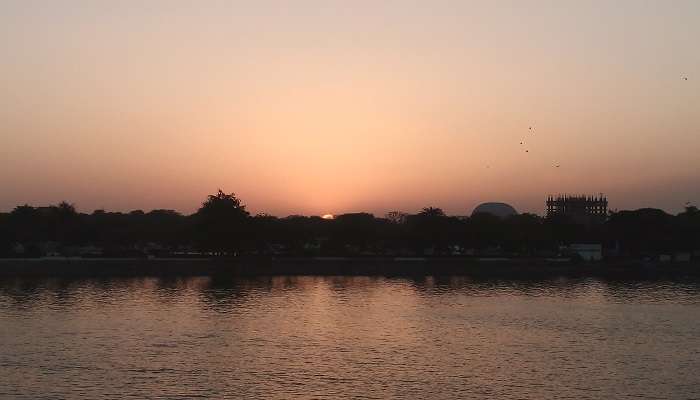
Situated just a short distance from the iconic Sidi Saiyyed Mosque, the Kankaria Lake offers a delightful setting for evening strolls, picnics, and memorable family outings. Spanning across 76 acres, this remarkable 34-sided artificial lake takes the shape of a polygon, creating a unique and visually captivating experience. With its expansive size, stretching around 2 km, the lake is a charming haven for relaxation and leisure. Flights of cut stone steps encircle the lake, providing convenient access to its tranquil waters. In addition, there are several slopes strategically placed around the lake, allowing visitors to dip their toes or take a refreshing swim easily.
Location: Kankaria, Ahmedabad, Gujarat 380002
Timings: open throughout the day
Jhulta Minar

The Jhulta Minar is also popularly known as the Shaking Minarets due to its unique structures, which have left architects and engineers dumbfounded for centuries. Considered to be one of the icons of Ahmedabad, each of these three-story tall minarets has balconies with intricate carvings. Two of the three minarets are located near the Kalupur railway station, one opposite Sarangpur Darwaja and the other named Malik Saranhther. These minarets and the central gateway were once part of the Sidi Bashir Mosque.
Location: 5, Julta Minar Rd, Manhar Nagar Society, Rajpur Hirpur, Gomtipur, Ahmedabad, Gujarat 380038
Timings: 7:00 am to 7:00 pm
Suggested Read: Temples In Ahmedabad
Sarkhej Roza
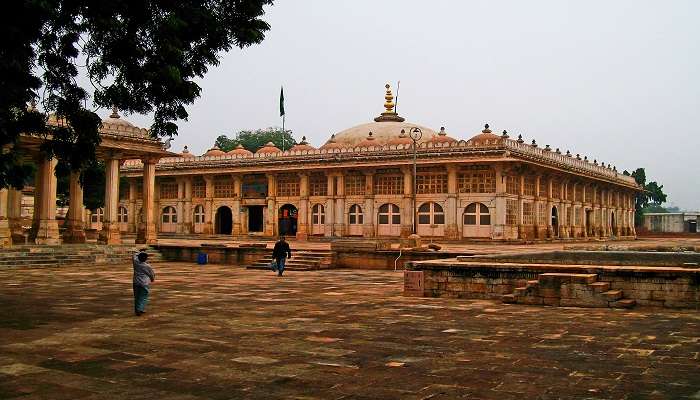
Located about 8 km from Ahmedabad, Sarkhej Roza is one of the most elegant and attractive architectural complexes in the state of Gujarat. Here, you will find the tombs of Saint Ahmad Khattu Ganj Baksh (1445), Mehmud Shah Begada, a prominent leader of Gujarat Sultanate (1511), and his queen, their palace, pavilions, and mosque, all clustered together surrounding a huge, complex-stepped tank. These structures are remarkable from an architectural point of view and draw visitors from across the country.
Location: Post Jeevraj Park, Sarkhej Makarba Rd, Makarba, Ahmedabad, Gujarat 380051
Timings: 9:00 am to 6:00 pm
Swaminarayan Temple
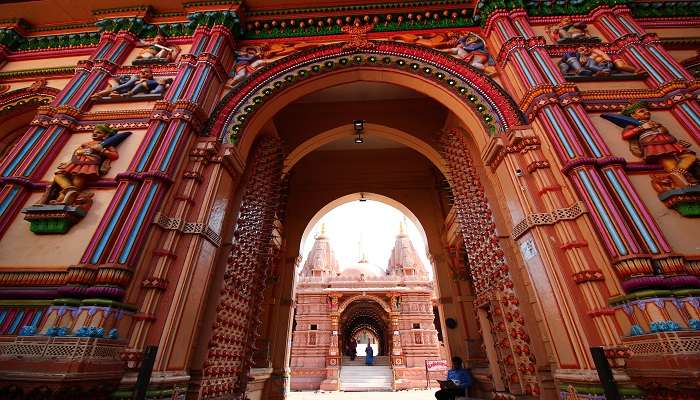
The Shri Swaminarayan temple is the first temple of the Swaminarayan Sampraday in Ahmedabad, located in the Kalupur area. It was built on the instructions of Swaminarayan, the founder of this sector. This temple is considered to be the headquarters of the Nar Narayan Dev Gadi, and green and yellow sculptures of Hindu gods and their bodies fitted in opulent dresses cover the structure of this nineteenth-century temple. The temple’s architecture is based on Burma teakwood, and all coloured arches and brackets are of different shades.
Location: Swaminarayan Mandir Road, Old City, Kalupur, Ahmedabad, Gujarat 380001
Timings: 5:00 am to 12:00 pm and 4:00 pm to 8:00 pm
Suggested Read: Romantic Restaurants In Ahmedabad
Jama Masjid
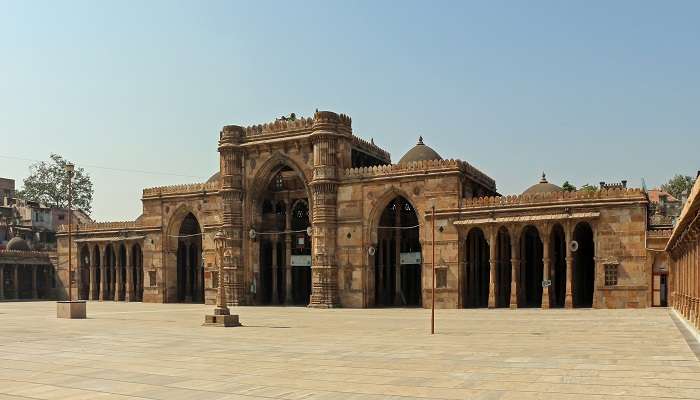
The Jama Masjid, situated on Mahatma Gandhi Road, was built by Ahmad Shah in 1423 and ranks as one of India’s most beautiful mosques. An enormous and peaceful courtyard enhances it. Similar to that of many Jain temples, lotus-like carvings on some domes display the mosque’s architectural fusion with Hindu and Jain religions. The Jama Masjid, supposedly the largest mosque in the Indian subcontinent, is the principal place of prayers for Muslims in that region.
Location: 2HFP+HR5, Manek Chowk, Gandhi Rd, Danapidth, Khadia, Ahmedabad, Gujarat 380001
Timings: 6:00 am to 8:00 pm
Bhadra Fort
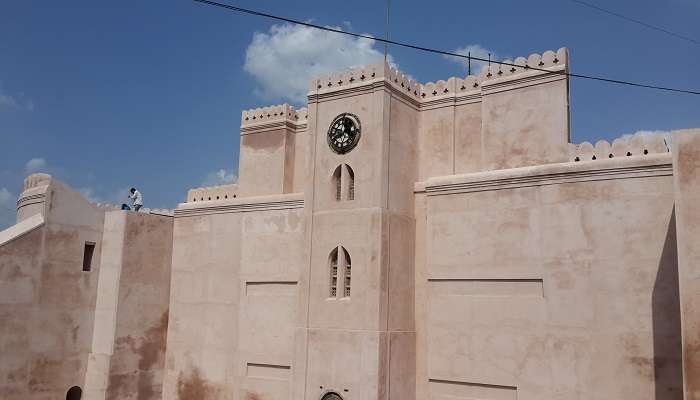
Want to get a bird’s view of the old city of Ahmedabad, then climb up to Bhadra Fort? Located not just a kilometre from the mosque, you will come across Bhadra fort which was also built by Ahmad Shah when the city was founded around 1411. Bhadra Fort now houses government offices and a Kali temple. The fort’s name was derived from the Bhadrakali temple, which is also located in close proximity. The fort’s gate formed the eastern entrance of the Ahmedabad citadel, which stretches west to the river. You can check out the imposing structure and views of the surrounding streets from the roof of this fort.
Location: Court Rd, Old City, Bhadra, Ahmedabad, Gujarat 380001
Timings: Open 24 hours
Suggested Read: Romantic Places Near Ahmedabad
Best Time To Visit Sidi Saiyyed Mosque
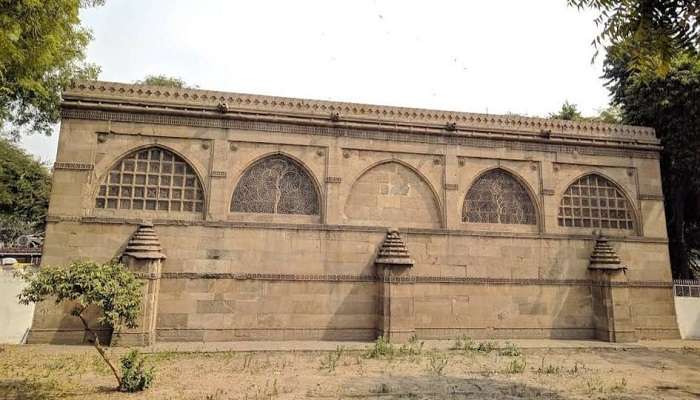
The best time to consider when planning your visit to Sidi Saiyyed Mosque is from the months November to March. The winter season remains as a pleasant and suitable time to visit as the summer season in Ahmedabad can cause rashes and itching on the skin due to its extreme heat conditions.
Since it is also peak season during the winters, expect a little crowd wherever you go, but if you want to beat the crowd, then you can visit during the moderate weather months, that is, August to October. Ahmedabad is a heritage destination, and you will find visitors all year round.
How To Reach Sidi Saiyyed Mosque
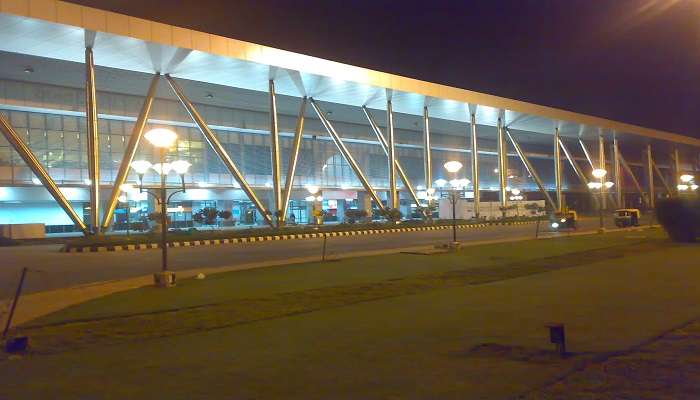
Located near Lal Darwaja in Ahmedabad, in the northwest corner of Bhadra Fort, the Sidi Saiyyed Mosque can be easily spotted opposite the Electricity house on Salapose Road. This mosque can be easily accessed by road since Ahmedabad boasts an excellent road network.
The nearest airport to the mosque, 10km away, is the Sardar Vallabhai Patel Airport. Located 6km from the mosque, you will find Ahmedabad and Kalupur railway stations, which are well-connected to all major cities in India. Moreover, both private and government buses operate from Gita Mandir near Kalupur railway station and Paldi bus stops.
Further Read: Tourist Places In Ahmedabad
Sidi Saiyyed Mosque Ahmedabad stands as a gateway towards unearthing the little-known history of the African diaspora in India. This holy site epitomises the grandeur and splendour of the Indo-Saracenic style of architecture, where the Tree of Life Jalis is a photographer’s delight. So, if you are planning a trip to Ahmedabad, take advantage of visiting this historical and spiritual place.
For our editorial codes of conduct and copyright disclaimer, please click here.
Cover Image Credit: Bernard Gagnon for Wikimedia Commons
Frequently Asked Questions About Sidi Saiyyed Mosque
How old is the Sidi Saiyyed Mosque?
The Sidi Saiyyed Mosque, also locally known as Sidi Saiyyed ni Jali, was built in 1572-1573 AD, which is around 600 years of age.
Who built the Sidi Saiyyed Mosque?
The mosque was believed to have been built by a Habshi nobleman called Sidi Saiyyed in the year 1572-1573.
What is the dress code for entering the Sidi Saiyyed Mosque?
Since the mosque is still in service, please be accurately dressed, remember that no shorts or revealing clothes are allowed while you visit this holy place. Also, please remember to remove your shoes before entering.
Are tourists allowed to take photographs inside the mosque?
Photography is usually restricted inside the mosque to preserve its historical and cultural integrity. Visitors are advised to check the rules and guidelines for clicking photos.
Why should you visit the Sidi Saiyyed Mosque?
The Sidi Saiyyed Mosque is one of the must-visit sites for travellers to Ahmedabad for its incredible architecture and the world-famous jalis.
People Also Read:
Hazratbal Mosque Sheikh Zayed Mosque Blue Mosque

Unveil the hidden treasures of the globe and turn every travel dream into reality. As a Content Writer, I am passionate enough to craft stories from ancient wonders to modern marvels. My words paint the picture-perfect itinerary for unforgettable experiences. Let my words be your trusted guide to immerse in the diverse culture and discover the beauty of the unknown.











